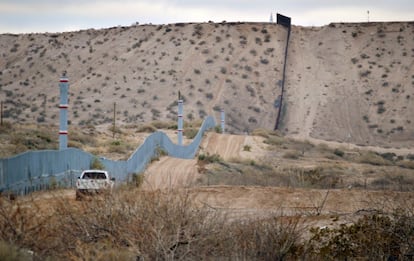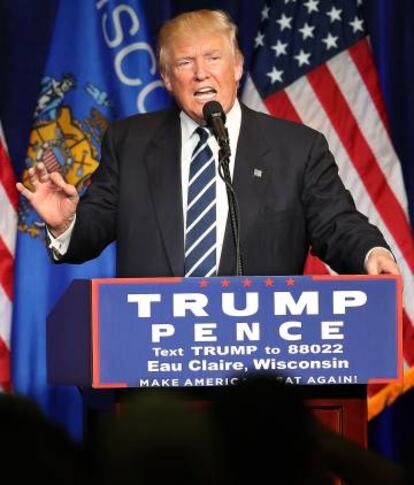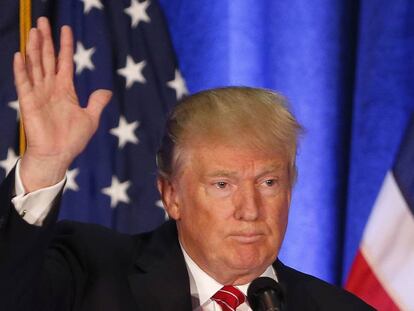The economic border not even Donald Trump can block
Entire cities along the US-Mexican border depend on the $530 billion trade between both nations


From the US-Mexican border, the horizon looks like a postcard. Tall glass towers rise up behind the factories. The manufacturing plants are in Mexico and the corporate offices are on American soil.
This border land between El Paso, Texas and Ciudad Juárez, Chihuahua is home to more than 2.2 million residents who are separated by the Rio Grande and an infinite steel fence, although they are united by a billion-dollar symbiotic trade relationship.
Juárez got the rougher side of the deal: hundreds of factories with thousands of workers who assemble products for sale in the north, on the other side where the skyscrapers stand.
To take the companies to the United States is crazy because, in globalization, companies compete over costs and profit
Ángel Calderón, analyst
Ciudad Juárez has grown in the last four decades thanks to the maquiladoras —the manufacturing plants that import supplies and export finished goods ready for sale. The industry has built 12 industrial parks throughout this urban center, home to 330 factories, most of them American-owned.
These plants make TV sets, washing machines, clothes, and parts for cars and planes. The most important reason manufacturers came to this region is the availability of cheap labor: 265,000 people work here for about four dollars a day.
“What Mexico has done is give large American companies the possibility to sell their products at a better price and to be more competitive. Otherwise they would lose that possibility,” explains Ángel Calderón, a lecturer at the School of Economics at the Autonomous University of Ciudad Juárez.

The assembly work in Juárez could be moved to El Paso, but then labor costs would be eight times higher, making it a very unlikely scenario despite the fact that Republican candidate Donald Trump promises to bring back American factories if he wins the White House next week.
Trump’s proposal seems like a crazy idea to María Rojas. “This man does not know the suffering of the Mexicans who have to work here.” Rojas, 42, is waiting in front of an assembly plant for a job. She has been walking around the industrial park closest to the border all day to see if she gets lucky.
Rojas finished elementary school at age 13 and began working in the factories. She saw her brother get electrocuted and die in a plant, and endured long periods of unemployment during the 2008 economic crisis.
Never in her life has she considered crossing the border without papers because, she says, assembly plants have provided enough work. Twenty-two percent of the manufacturing industry in Mexico is in Ciudad Juárez and most of its workers —approximately 70%— are women.
The 1994 North American Free Trade Agreement (NAFTA) catapulted the border assembly plants, but it did not prepare the industry for the reversals in the global economy.
The assembly work in Juárez could be moved to El Paso, but then labor costs would be eight times higher
“Assembly plants do not generate suppliers,” Calderón says. “ Even though 64 percent of the city depends on the export-assembly industry, only 2.5 percent of the plants’ supplies are Mexican,” he explains.
Ciudad Juárez has slowly recovered its industrial drive since the 2008 crisis, but neither salaries nor the revenues of the exporters who must exchange Mexican pesos for an expensive US dollar reflect that growth. “We have several benefits but if we could earn a little more, it would be better. It’s something that we need,” says Claudia Busso, a 45-year-old worker who assembles aircraft spare parts.
Streets on the other side of the border are lined with shops filled with cheap products imported from China. The Asian country competes with Mexico’s assembly industry but the Latin American nation continues to have an economic edge because of the border with the United States. At least six million jobs in the north depend on trade with Mexico. Business between the two countries is worth $530 billion a year and Mexico makes $296 billion in exports. One million people travel through 58 crossing points along this 3,201-kilometer border every day.
“All this is what has allowed Mexican products to be competitive with respect to China and other Asian countries,” Calderón explains. “To take the companies to the United States is crazy because, in the end, in globalization, companies are competing over costs and profit.”
English version by Dyane Jean François.
Tu suscripción se está usando en otro dispositivo
¿Quieres añadir otro usuario a tu suscripción?
Si continúas leyendo en este dispositivo, no se podrá leer en el otro.
FlechaTu suscripción se está usando en otro dispositivo y solo puedes acceder a EL PAÍS desde un dispositivo a la vez.
Si quieres compartir tu cuenta, cambia tu suscripción a la modalidad Premium, así podrás añadir otro usuario. Cada uno accederá con su propia cuenta de email, lo que os permitirá personalizar vuestra experiencia en EL PAÍS.
En el caso de no saber quién está usando tu cuenta, te recomendamos cambiar tu contraseña aquí.
Si decides continuar compartiendo tu cuenta, este mensaje se mostrará en tu dispositivo y en el de la otra persona que está usando tu cuenta de forma indefinida, afectando a tu experiencia de lectura. Puedes consultar aquí los términos y condiciones de la suscripción digital.










































